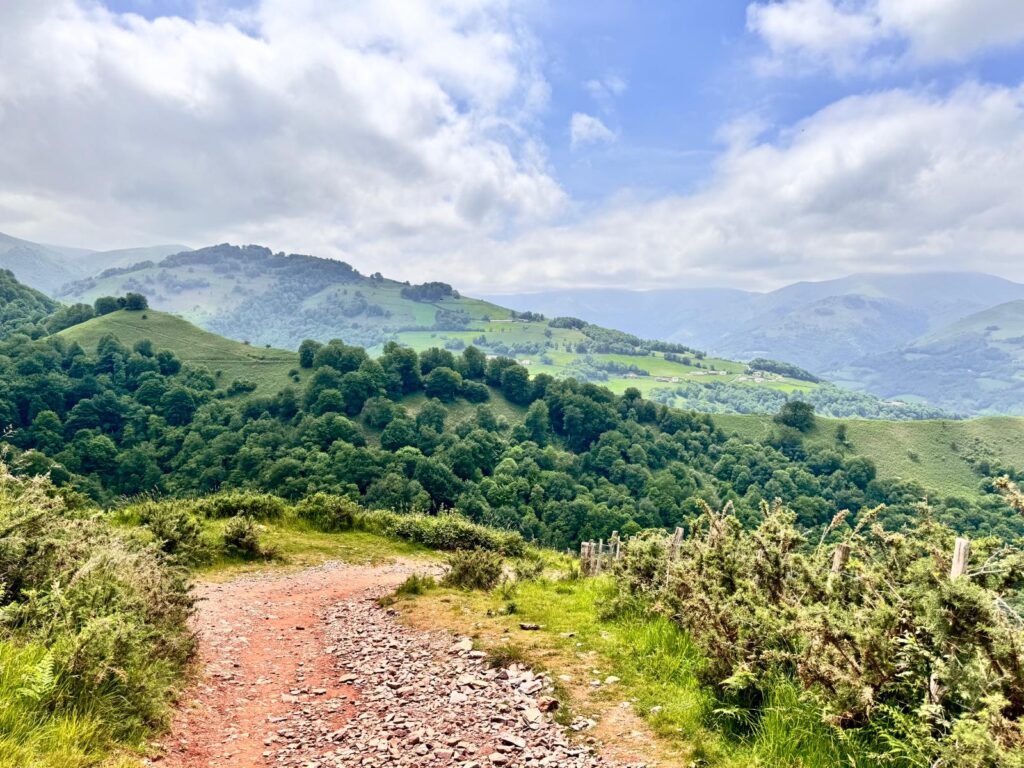Our Camino began not on a trail, but aboard an overnight sleeper train SNCF from Paris. At exactly 9:40 PM, we boarded the train bound for Bayonne, feeling equal parts excitement and uncertainty.
Our six-bunk, mixed-gender cabin was surprisingly cozy. We took the two topmost bunks, climbing up with our backpacks and anticipation. Each berth was equipped with a reading light, a charging port (thankfully!), and a thoughtful little sleeping kit containing earplugs, an eye mask, a couple of wet wipes, and even a mint. What really made us smile was the sudoku puzzle printed on the kit’s packaging—with answers included! A small but charming touch of French hospitality.
We slept through most of the ride, waking only to keep each other company during quiet trips to the shared toilet. Before we knew it, morning light crept in, and by around 8 AM, we rolled into Bayonne.
From there, we hopped onto a small connecting train to Saint-Jean-Pied-de-Port (SJPDP)—a quaint little train that seemed to exist solely for pilgrims. The air was charged with nervous energy and hopeful smiles; everyone aboard was a fellow traveler, eyes already set on the mountains ahead.
By 10 AM, we arrived at SJPDP. Any anxiety about what to do next quickly dissolved—we simply followed the stream of pilgrims headed straight to the Pilgrim Office. The process was smooth and welcoming. We registered our journey, received a helpful map and albergue list, and made a small donation for the iconic scallop shell to hang on our backpacks (because let’s be honest, it is part of the Camino look). To our surprise, we were told we were the only Singaporeans registered that day! We also arranged for our luggage to be forwarded to our next next stop (Roncesvalles) —lightening our load for the walk ahead. By 12:30 PM (a bit late in hindsight), we were finally on our way.
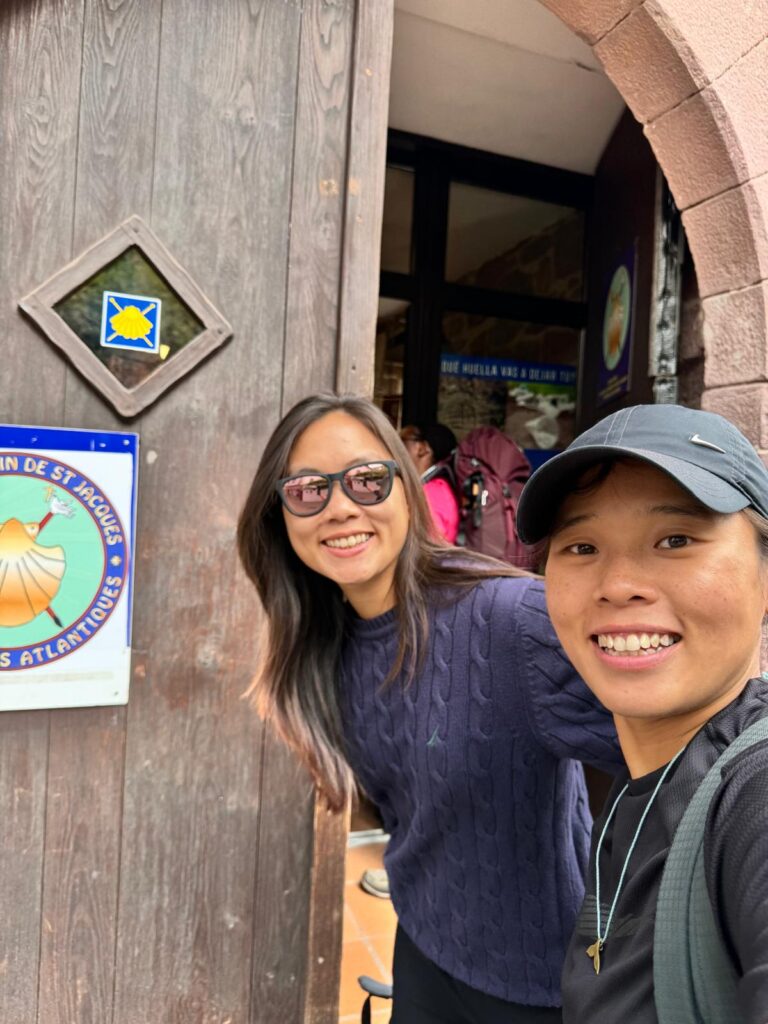
Day 1 Trail Stats (SJPDP to Orisson)
Distance: 4.6 miles / 7.4 km
Elevation Gain: 2,260 feet / 689 meters
Estimated Hiking Time: 2 hours 37 minutes
…though if you’re anything like us, add a few snack breaks, photo stops, panting-in-the-shade moments, and “why are we doing this” pauses—and you’re looking at more like 3 hours+ .
This stretch is short in distance but steep and unrelenting.
The trail greeted us with a steady incline on asphalt roads, a gentle but firm reminder that the Camino doesn’t wait. We walked in the warmth of midday sun, our feet already learning the rhythm of pilgrimage.
And so it began—our Camino.
Just after the 5km mark, the Camino left the paved road and veered sharply uphill onto a steep gravel and sand trail. It felt like the incline would never end. Thank goodness we were Team Walking Sticks—those poles saved our knees and gave us something to lean on as we trudged upward.
The view was absolutely breathtaking—rolling hills fading into the horizon—but the heat was intense. We stopped often, catching our breath under patches of shade (whenever we could find them). Pilgrims passed us with surprising ease, and we couldn’t help but think, Oh no, it’s only Day 1 and we’re already behind?! Are we weak… or what?! But somewhere between gasping for air and sipping water, we learned to let go of those thoughts and embrace our own rhythm.
At this stage of the Camino, the usual “Buen Camino!” greeting wasn’t flying around just yet. Instead, it was more of a shared “Hey, how are you holding up?”—a quiet camaraderie in the sweat and struggle of the first day.
Eventually, the gravel gave way to asphalt again, but the ascent continued. Up, up, and still more up. Just as our morale was dipping and we started to wonder, When is this going to end?, we turned a corner and there it was: a beautiful chalet in the middle of nowhere—Orisson! Orisson is a popular stop for good reason. If you’re considering it: book ahead, and enjoy the slow, rewarding climb into the Pyrenees the following day.
It was our first albergue of the Camino, and we were beyond relieved. While many pilgrims push through to Roncesvalles on Day 1, we had wisely (and gratefully) booked Orisson in advance. At 4:17 PM, we arrived, exhausted and thrilled. Sending our heavier backpacks onwards to Roncesvelles ahead had definitely been a smart move.
The view from Orisson? Absolutely unreal—rolling mountains, low-hanging clouds, and the feeling of being on top of the world.
We finally had our first proper meal of the day (not something we’d recommend doing again—maybe grab breakfast next time in SJPDP or stay a night there, explore the town and do the climb earlier in the morning after a good rest.) A baguette sandwich with cured meat and cheese, a warm bowl of either tomato or carrot soup, and of course… red wine. We shared everything and ate slowly, just soaking it all in. Dinner was included in the booking—one of those warm, communal meals that bring pilgrims together at long tables.
The albergue itself was simple but welcoming. Two rooms with nine beds each, basic but clean. We were given a sheet and pillowcase to put on ourselves—a ritual that quickly became second nature on the Camino. For showers, we were handed a single coin, good for five precious minutes of hot water.
Looking back, Orisson ended up being one of the most expensive stays on the whole Camino. But at that moment, it was worth every euro.
(For real-time info, booking tips, and essential Camino apps, I wrote a post here
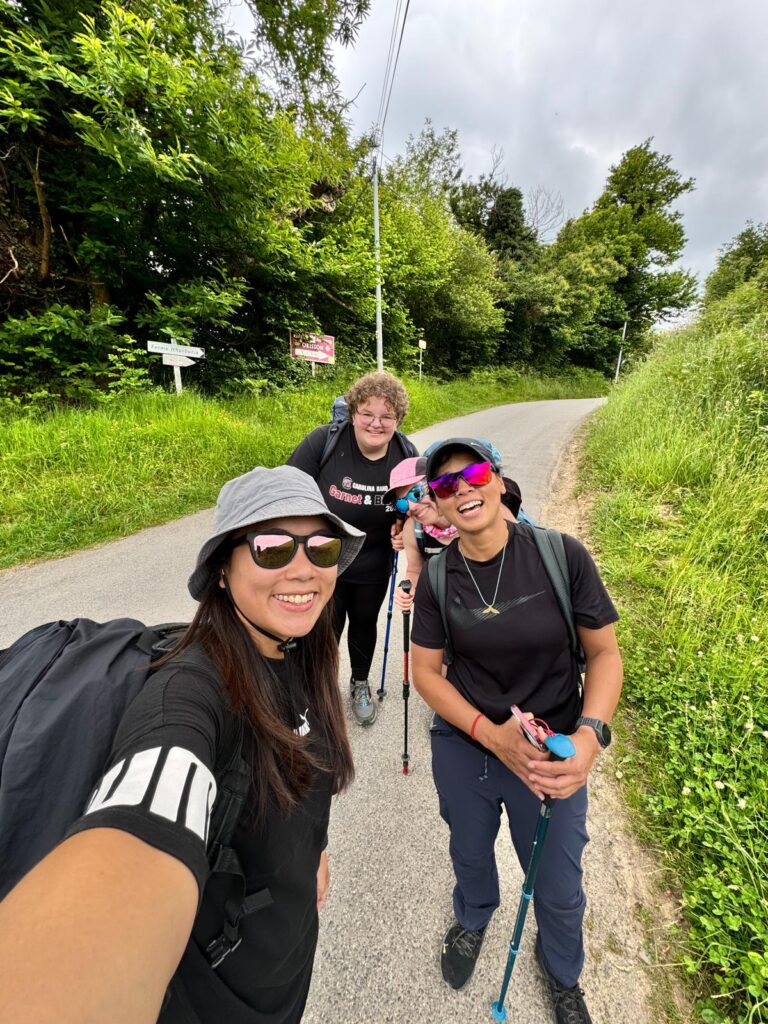
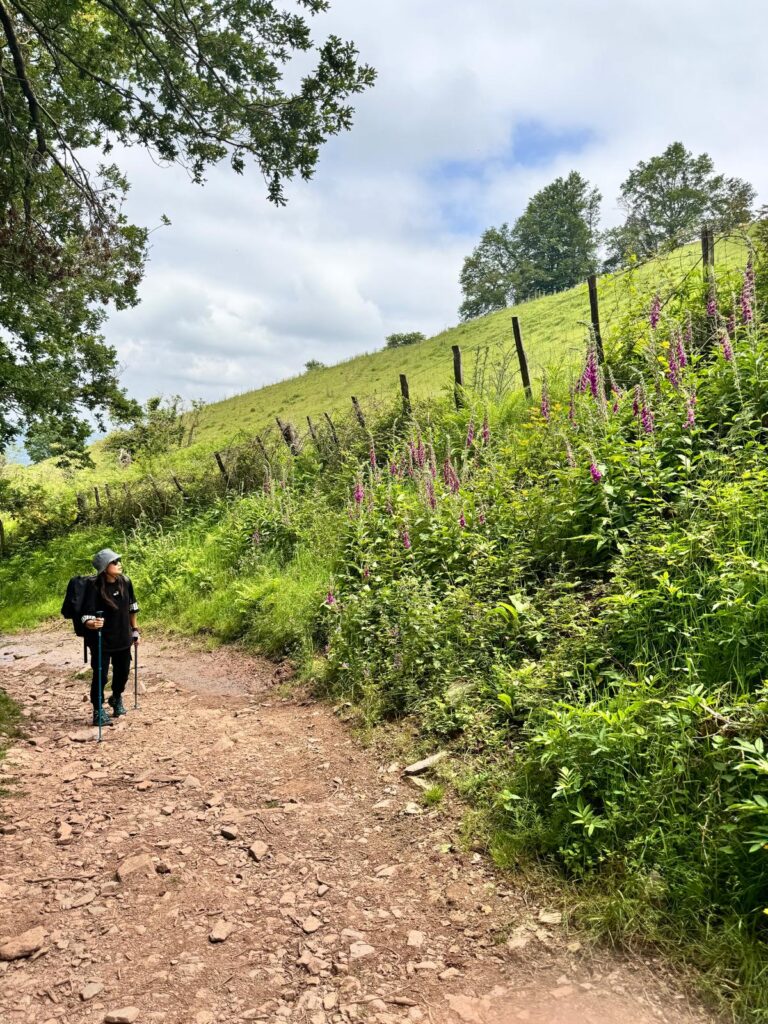
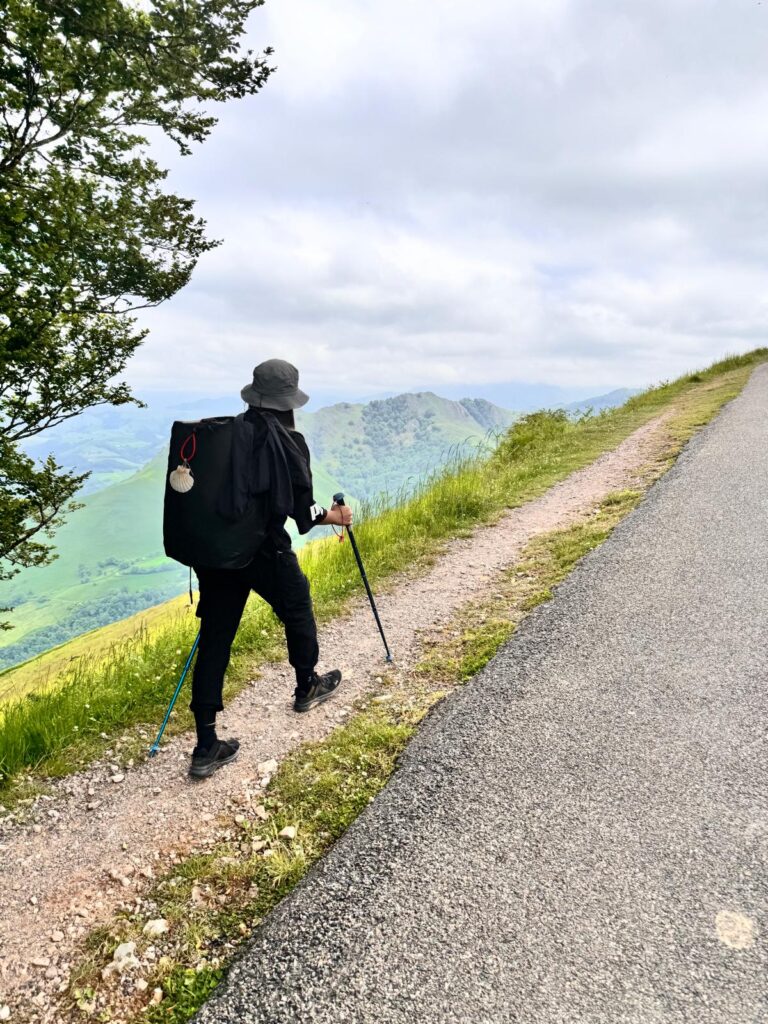
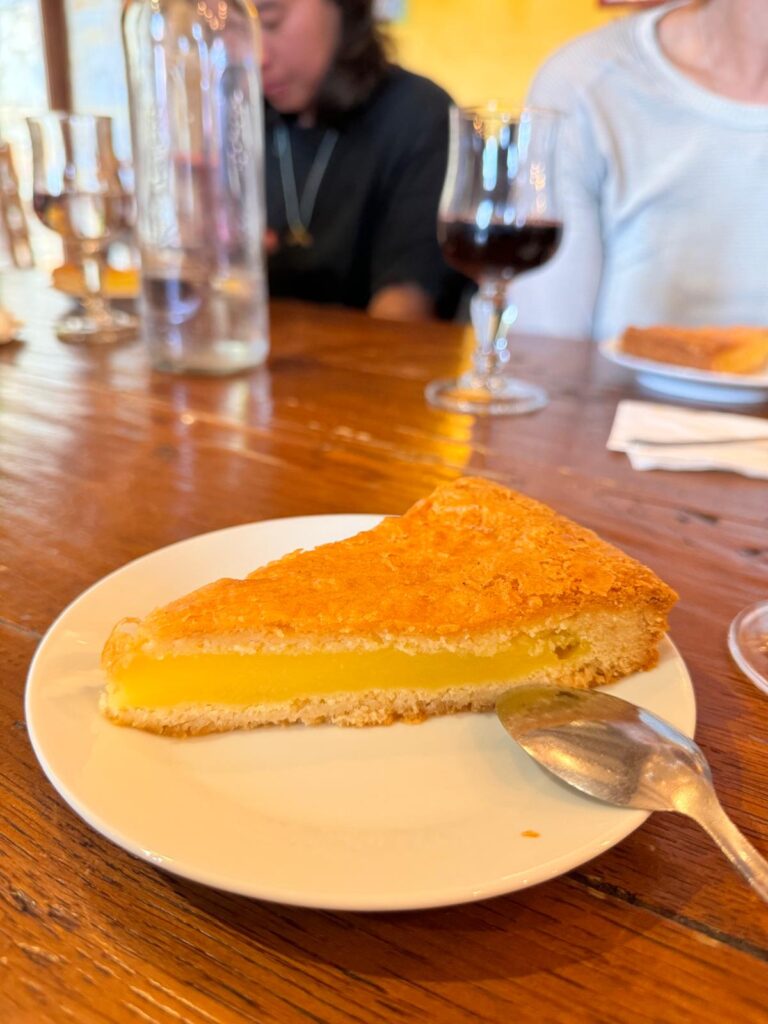
Dinner at Orisson was one of those moments that really stayed with us—not just because we were starving or that the food was particularly good, but because it felt like the true beginning of the Camino spirit.
By early evening, all the pilgrims gathered around long communal tables in the dining area. The vibe was warm, a little shy at first, but filled with anticipation. Everyone had made it through Day 1, and now we were about to share our first proper Camino meal together.
The dinner itself was humble but deeply satisfying. The starter was a warm, comforting bowl of tomato or carrot soup, perfect after a hot and hilly hike. For the main, we were served thinly sliced pork—simple, tender, and flavorful—paired with some roasted vegetables or potatoes (memory’s a little fuzzy, but it was good!).
And of course, no French mountain meal would be complete without local red wine, poured generously and often. We clinked glasses with people we’d just met, laughing at the shared pain of steep climbs and blisters already forming.
Then came the famous almond pie—yes, that almond pie. Buttery, slightly sweet, with a hint of crunch and just the right touch of rustic simplicity. It’s actually called Tarta de Santiago, a traditional Spanish almond cake that’s iconic along the Camino. You’ll find it in cafés, bakeries, and albergues throughout the route.
Often, it’s dusted with powdered sugar in the shape of the Cross of Saint James, a subtle but meaningful symbol for pilgrims walking the Way. It wasn’t anything fancy, but after a long, hot day of hiking, it hit the spot. A humble slice of regional tradition, and our first sweet taste of what the Camino would be all about.
What truly made the evening special, though, was the pilgrim introduction round. Each person stood up and shared their name, where they were from, and why they were walking. Some stories were moving, some funny, some quiet and deeply personal. It felt like the walls dropped and we were no longer strangers—we were fellow travelers, each walking for our own reason, but somehow walking together.
That dinner set the tone for everything that followed: connection, simplicity, shared stories, and always—always—a little wine and something sweet at the end.
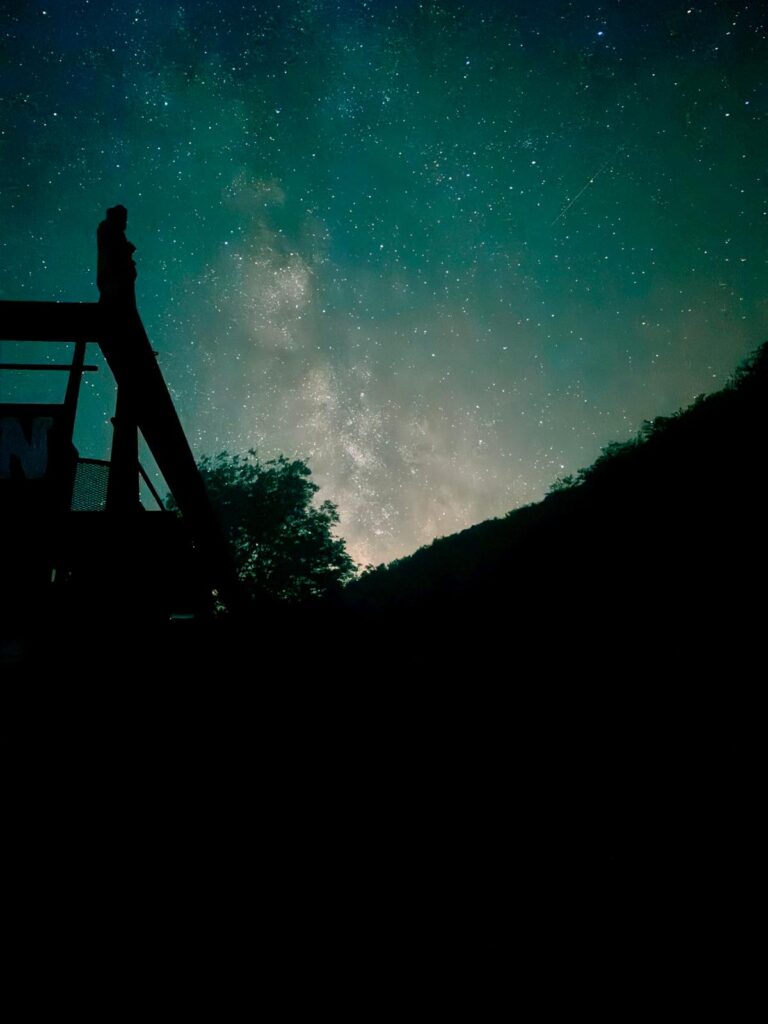
The 7.4 km uphill trek to Orisson was short but intense, with steep ascents, blazing sun, and many reflective pauses. We sent our backpacks ahead and took our time, leaning on walking sticks and letting go of expectations. Arriving at the Orisson Albergue felt like a true reward—complete with sweeping views, a hearty lunch, and our first communal dinner, where stories and connections quietly began to form. Though physically challenging, the day marked a powerful emotional beginning to our Camino.
